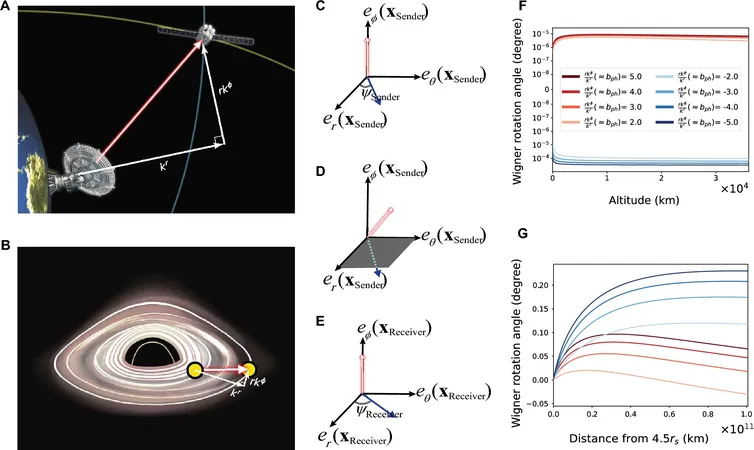
Unlocking the Universe: How Light's Secrets Could Solve Gravity and Quantum Mysteries
2025-05-12
Author: Jia
In an astonishing breakthrough, a team of visionary physicists has uncovered a groundbreaking method to tackle one of the biggest challenges in modern science: bridging the gap between Einstein's gravity and the enigmatic world of quantum mechanics.
Despite decades of tireless research, the relationship between gravity— which rules over the massive bodies like planets—and quantum mechanics— which explains the behavior of tiny particles—has remained elusive. But excitingly, the scientists argue that the answer might lie within the very nature of light.
Led by Dr. Warner A. Miller from Florida Atlantic University's College of Science, alongside collaborators from the University of Seoul and Seoul National University, the team delved into the intriguing behavior of light's polarization — the direction in which it vibrates during its journey. Their groundbreaking study reveals that phenomena occur with light passing through curved space that defy conventional understanding.
Typically, light’s polarization alters slightly due to gravity's warping of space — a well-established effect. However, the researchers found something even more profound: by manipulating how light is measured, they could invoke a peculiar phenomenon known as non-reciprocity.
"Non-reciprocity means that light behaves differently on its way forward than on its return path," Miller explains. "This finding challenges the assumption that light always reverts to its original state after traversing a closed loop, even when affected solely by gravity."
The crux of their discovery hinges on the quantization axis, which determines how a polarizer measures the light. Tweaking this axis allowed the team to significantly amplify the effects they observed. Remarkably, the Wigner Rotation Angle (WRA)—the polarization shift—can be magnified to an astonishing tenfold beyond what gravity would typically induce, even in the extreme environments near black holes.
"By fine-tuning the system, we can enhance the minute influences that gravity has on light's polarization," Miller emphasized. "This innovative approach equips us with a powerful new tool to investigate the potential connections between gravity and quantum mechanics."
To validate their predictions, the researchers propose constructing an astronomical interferometer—a sophisticated array of satellites outfitted with targeted polarizers, designed to capture these amplified shifts.
They envision two cutting-edge designs: one that fuses the precision of a Hong–Ou–Mandel setup with a Mach–Zehnder interferometer to eliminate noise, and a second that incorporates a tightly controlled light source to juxtapose quantum predictions against classical expectations.
These experiments hold enormous potential; they could unravel whether this new non-reciprocal light behavior unveils interactions between quantum properties—like spin and polarization—and classical gravitational fields. Intriguingly, this effect could stem from any polarization rotation, not just those instigated by gravity, paving the way for exploring new physics that might challenge Einstein's principles or provide insights into quantum gravity.
"This isn't just another experiment; it’s a fresh avenue for probing the most profound questions in physics," Miller stated, emphasizing the transformative nature of their findings.
While the ambitious experiments are spearheaded for space, the team is optimistic that some effects could also be tested in a lab environment, utilizing mirrors and polarizers to replicate necessary conditions. If corroborated, these non-reciprocal polarization shifts could revolutionize our understanding of the universe, enabling scientists to delve deeper into the fabric of reality, the nature of light, and the complex relationship between gravity and quantum mechanics.
 Brasil (PT)
Brasil (PT)
 Canada (EN)
Canada (EN)
 Chile (ES)
Chile (ES)
 Česko (CS)
Česko (CS)
 대한민국 (KO)
대한민국 (KO)
 España (ES)
España (ES)
 France (FR)
France (FR)
 Hong Kong (EN)
Hong Kong (EN)
 Italia (IT)
Italia (IT)
 日本 (JA)
日本 (JA)
 Magyarország (HU)
Magyarország (HU)
 Norge (NO)
Norge (NO)
 Polska (PL)
Polska (PL)
 Schweiz (DE)
Schweiz (DE)
 Singapore (EN)
Singapore (EN)
 Sverige (SV)
Sverige (SV)
 Suomi (FI)
Suomi (FI)
 Türkiye (TR)
Türkiye (TR)
 الإمارات العربية المتحدة (AR)
الإمارات العربية المتحدة (AR)